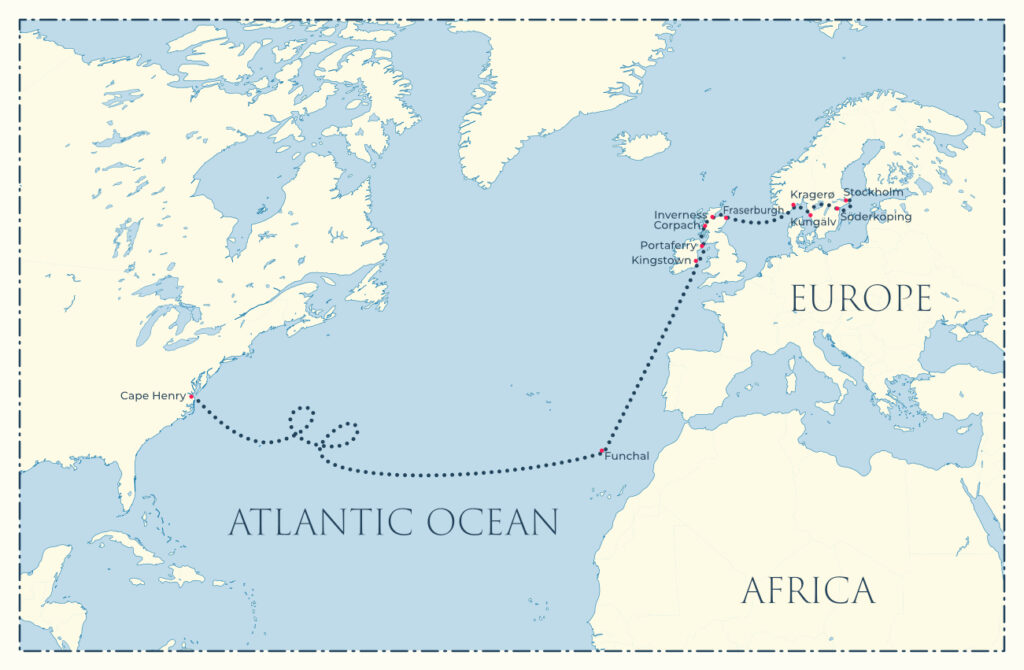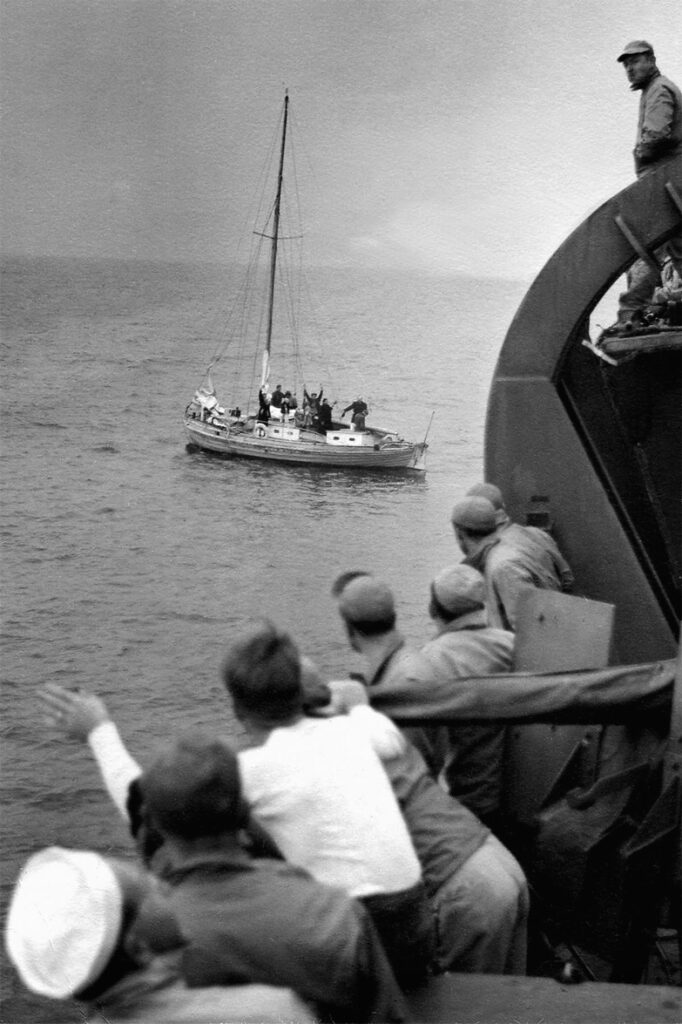Boats

Från Sverige seglade majoriteten av flyktingbåtarna runt Norge och Danmark, med stopp i Skottland och Irland, ibland England, innan de fortsatte söderut över Biscayabukten till Spanien och Madeira. Därifrån drog båtarna nytta av passadvindarna för att segla till Nordamerika. Kartan ovan skildrar en typisk rutt, inklusive Atlantiska stormar som nästa kapsejsade flera av skeppen.
Resor till USA
För flyktingar på flykt undan kommunismen efter andra världskriget framstod Amerika som en trygg hamn, i och med titeln “land of the free” (de frias land). USA, till skillnad från Sverige, hade vägrat erkänna den sovjetiska ockupationen av de baltiska staterna 1940 och diplomatisk representation i exil fortsatte verka fram tills självständigheten återställdes 1991. Ernst Jaakson, den legendariska generalkonsulen i New York, stöttade flyktingarna i Amerika.
De första “vikingabåtarna” som anlände 1945 lyckades samla ihop folkligt stöd för de modiga sjömännen. Amerika var redan bekant med Kõu Valter, kapten av Estonia, eftersom han tillsammans med sin bror hade seglat över Atlanten i en 8-meter lång segelbåt 1930 och de till följd av detta blivit mediakändisar.
Erma, en 11.2-meter lång slop anlände kort därpå, och slutförde en resa som senare förevigades i boken Sailing to Freedom (Segla för livet på svenska). Boken, som kom ut 1952, var medförfattad av passageraren Voldemar Veedam, och blev en internationell bästsäljare, översatt till 30 språk.
Trots offentlig beundran för de modiga seglarna tillbringade i stort sett alla flyktingarna månader på Ellis Island i New York innan de framgångsrikt fick tillåtelse att immigrera. Passagerarna ombord Edith nekades inträde och efter månader på Ellis Island finansierade den lutherska kyrkan i Kanada deras flytt till Kanada istället.
Ankomsten av flyktingarna satte igång en debatt om amerikansk immigration. Kvoter som satts 1924 och som tillät 124 ester, 142 letter och 344 litauer om året att invandra, var otillräckliga i efterkrigstidens era. Med kalla kriget, påeldat av McCarthyism, som bakgrund, bidrog de dramatiska berättelserna om flyktingarna som flydde kommunismen och riskerade allt för att leva i frihet till förändringar i migrationslagstiftningen.
President Harry S. Trumans Displaced Persons Act från 1948 öppnade amerikas portar för över 400 000 efterkrigsflyktingar, och gjorde det därmed möjligt att invandra lagligt, något som hade varit en av de drivande faktorerna bakom de desperate båtresorna. Ytterligare lagstiftning till fördel för invandring kom strax därpå, och mellan 1948 och 1952 anlände 12 000 ester till USA.

Besättning ombord USS John P. Gray vinkar farväl till Erma. Den amerikanska flottans transportskepp fick syn på den lilla båten precis när den höll på att få slut på nödvändiga förnödenheter, och hjälpte till.
Båtnamn / Ankomstdatum / Passagerare / Destination
- Estonia / December 1945 / 5 / Miami, Florida
- Erma / 15 december 1945 / 16 / Little Creek, Virginia
- Inanda / 21 augusti 1946 / 18 / Miami, Florida
- Brill / 9 september 1946 / 12 / Miami, Florida
- Linda / 28 september 1946 / 18 / Miami, Florida
- Edith / 15 september 1947 / 24 / Savannah, Georgia
- Dockan / 1 oktober 1947 / 8 / Miami, Florida
- Svea / 26 oktober 1947 / 24 / West Palm Beach, Florida
- Gundel /20 juli 1948 / 29 / Boston, Massachusetts
- Roland / 18 augusti 1948 /15 / Southport, North Carolina
- Prolific / 20 september 1948 / 69 / Wilmington, North Carolina
- Eeva / 21 januari 1949 / 37 / Miami, Florida
- Parita / April 1949 / 43 / Baltimore, Maryland
- Skagen / 5 juli 1949 /16 / Boston, Massachusetts
- Måsen / 29 augusti 1950 / 108 / Boston, Massachusetts
- Aura / juli 1951 / 3 / New York, New York
- Walprio / 4 oktober 1951 / 11 / Fort Pierce, Florida
Totalt 456 passagerare
Källor: Baltimore Sun, 3 mars 1950; Välis-Eesti, 7 oktober 1951; Eestlased Kanadas, Canadian Estonian Historical Commission (1975); Estonians in America 1945-1995: Exiles in a Land of Promise, Estonian American National Council (2016); “The formation and development of the Estonian diaspora,” Journal of Ethnic and Migration Studies (2010). Bilder används med tillåtelse från Estlands sjöfartsmuseum.
